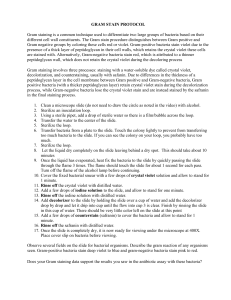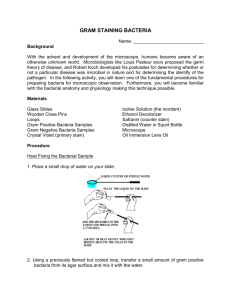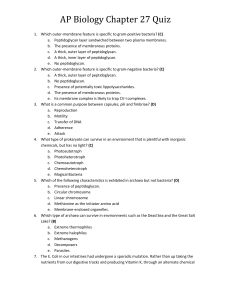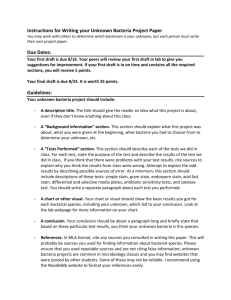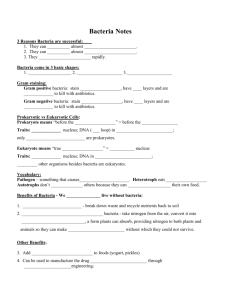The Gram Stain
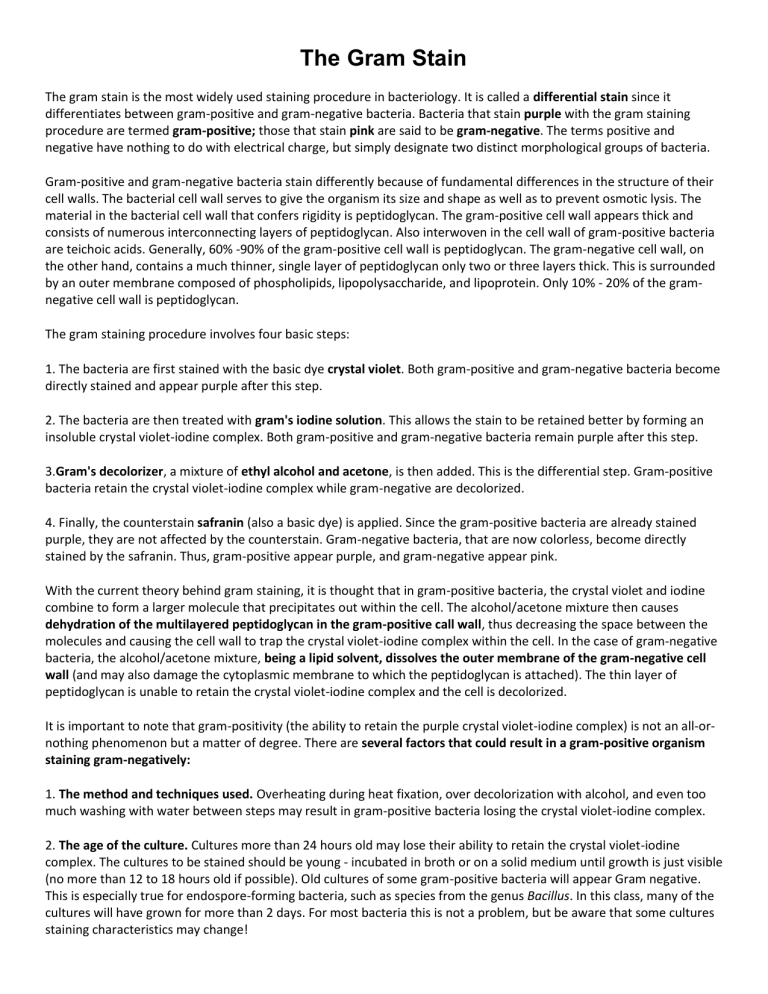
The Gram Stain
The gram stain is the most widely used staining procedure in bacteriology. It is called a differential stain since it differentiates between gram-positive and gram-negative bacteria. Bacteria that stain purple with the gram staining procedure are termed gram-positive; those that stain pink are said to be gram-negative. The terms positive and negative have nothing to do with electrical charge, but simply designate two distinct morphological groups of bacteria.
Gram-positive and gram-negative bacteria stain differently because of fundamental differences in the structure of their cell walls. The bacterial cell wall serves to give the organism its size and shape as well as to prevent osmotic lysis. The material in the bacterial cell wall that confers rigidity is peptidoglycan. The gram-positive cell wall appears thick and consists of numerous interconnecting layers of peptidoglycan. Also interwoven in the cell wall of gram-positive bacteria are teichoic acids. Generally, 60% -90% of the gram-positive cell wall is peptidoglycan. The gram-negative cell wall, on the other hand, contains a much thinner, single layer of peptidoglycan only two or three layers thick. This is surrounded by an outer membrane composed of phospholipids, lipopolysaccharide, and lipoprotein. Only 10% - 20% of the gramnegative cell wall is peptidoglycan.
The gram staining procedure involves four basic steps:
1. The bacteria are first stained with the basic dye crystal violet. Both gram-positive and gram-negative bacteria become directly stained and appear purple after this step.
2. The bacteria are then treated with gram's iodine solution. This allows the stain to be retained better by forming an insoluble crystal violet-iodine complex. Both gram-positive and gram-negative bacteria remain purple after this step.
3.Gram's decolorizer, a mixture of ethyl alcohol and acetone, is then added. This is the differential step. Gram-positive bacteria retain the crystal violet-iodine complex while gram-negative are decolorized.
4. Finally, the counterstain safranin (also a basic dye) is applied. Since the gram-positive bacteria are already stained purple, they are not affected by the counterstain. Gram-negative bacteria, that are now colorless, become directly stained by the safranin. Thus, gram-positive appear purple, and gram-negative appear pink.
With the current theory behind gram staining, it is thought that in gram-positive bacteria, the crystal violet and iodine combine to form a larger molecule that precipitates out within the cell. The alcohol/acetone mixture then causes
dehydration of the multilayered peptidoglycan in the gram-positive call wall, thus decreasing the space between the molecules and causing the cell wall to trap the crystal violet-iodine complex within the cell. In the case of gram-negative bacteria, the alcohol/acetone mixture, being a lipid solvent, dissolves the outer membrane of the gram-negative cell
wall (and may also damage the cytoplasmic membrane to which the peptidoglycan is attached). The thin layer of peptidoglycan is unable to retain the crystal violet-iodine complex and the cell is decolorized.
It is important to note that gram-positivity (the ability to retain the purple crystal violet-iodine complex) is not an all-ornothing phenomenon but a matter of degree. There are several factors that could result in a gram-positive organism
staining gram-negatively:
1. The method and techniques used. Overheating during heat fixation, over decolorization with alcohol, and even too much washing with water between steps may result in gram-positive bacteria losing the crystal violet-iodine complex.
2. The age of the culture. Cultures more than 24 hours old may lose their ability to retain the crystal violet-iodine complex. The cultures to be stained should be young - incubated in broth or on a solid medium until growth is just visible
(no more than 12 to 18 hours old if possible). Old cultures of some gram-positive bacteria will appear Gram negative.
This is especially true for endospore-forming bacteria, such as species from the genus Bacillus. In this class, many of the cultures will have grown for more than 2 days. For most bacteria this is not a problem, but be aware that some cultures staining characteristics may change!
3. The organism itself. Some gram-positive bacteria are more able to retain the crystal violet-iodine complex than others.
4. The Media the bacteria is cultured on. When feasible, the cultures to be stained should be grown on a sugar-free medium. Many organisms produce substantial amounts of capsular or slime material in the presence of certain carbohydrates. This may interfere with decolorization, and certain Gram-negative organisms such as Klebsiella may appear as a mixture of pink and purple cells.
Therefore, one must use very precise techniques in gram staining and interpret the results with discretion.
PROCEDURE
1. Heat-fix a smear of a mixture of the bacterium as follows: a. Using the dropper bottle of distilled water found in your staining rack, place a small drop of water on a clean slide by touching the dropper to the slide. b. Aseptically remove a small amount of bacteria 1 from the agar surface and mix it generously with the water. Flame the loop and let it cool. Now aseptically remove a small amount of bacteria 2 and sparingly add it to the water. Flame the loop and let it cool. c. Using the loop, spread the mixture over the entire slide to form a thin film. d. Allow this thin suspension to completely air dry. e. Pass the slide (film-side up) through the flame of the bunsen burner 3 or 4 times to heat-fix.
2. Stain with crystal violet for one minute. Gently wash with water. Shake off the excess water but do not blot dry
between steps.
3. Stain with gram's iodine solution for one minute and gently wash with water.
4. Decolorize by adding gram's decolorizer drop by drop until the purple stops flowing. Wash immediately with water.
5. Stain with safranin for one minute and wash with water.
6. Blot dry and observe using oil immersion microscopy.
Analysis: Write questions and answers on separate sheet of paper and staple to the back. Answer in complete sentences.
1. Describe the appearance and growth characteristics of each of your bacteria on growth media.
2. Draw a color picture of your stained bacteria as they under oil immersion.
3. Describe your stained bacteria as they appear under oil immersion in as much detail as possible, differentiating them from each other as much as possible.
4. How certain can you be that your Gram stain results are correct? Explain your answer.
5. What could you do to improve your chances of getting accurate results with the Gram stain?

